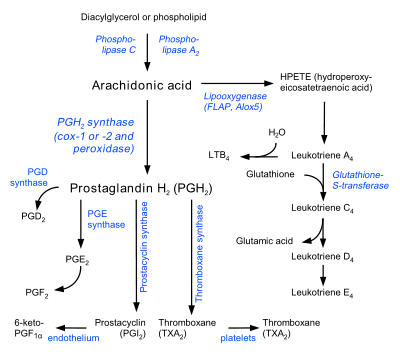
Thromboxane A2
Encyclopedia
Thromboxane A2 is a thromboxane
. It is produced by activated platelets and has prothrombotic properties: it stimulates activation of new platelets as well as increases platelet aggregation. This is achieved by mediating expression of the glycoprotein complex GP IIb/IIIa in the cell membrane of platelets. Circulating fibrinogen
binds these receptors on adjacent platelets, further strengthening the clot.
Receptors that mediate TXA2 actions are thromboxane A2 receptors
. The human TXA2 receptor (TP) is a typical G protein-coupled receptor (GPCR) with seven transmembrane segments. In humans, two TP receptor splice variants - TPα and TPβ - have so far been cloned.
by thromboxane-A synthase
. Aspirin
irreversibly inhibits platelet cyclooxygenase 1 preventing the formation of prostaglandin H2, and therefore thromboxane A2.
TXA2 is very unstable in aqueous solution, since it is hydrolyzed within about 30 seconds to the biologically inactive thromboxane B2
. Due to its very short half life, TXA2 primarily functions as an autocrine or paracrine mediator in the nearby tissues surrounding its site of production. Most work in the field of TXA2 is done instead with synthetic analogs such as U46619
and I-BOP. In human studies, 11-dehydrothromboxane B2
levels are used to indirectly measure TXA2 production.

Thromboxane
Thromboxane is a member of the family of lipids known as eicosanoids. The two major thromboxanes are thromboxane A2 and thromboxane B2. The distinguishing feature of thromboxanes is a 6-membered ether-containing ring....
. It is produced by activated platelets and has prothrombotic properties: it stimulates activation of new platelets as well as increases platelet aggregation. This is achieved by mediating expression of the glycoprotein complex GP IIb/IIIa in the cell membrane of platelets. Circulating fibrinogen
Fibrinogen
Fibrinogen is a soluble plasma glycoprotein, synthesised by the liver, that is converted by thrombin into fibrin during blood coagulation. This is achieved through processes in the coagulation cascade that activate the zymogen prothrombin to the serine protease thrombin, which is responsible for...
binds these receptors on adjacent platelets, further strengthening the clot.
Receptors that mediate TXA2 actions are thromboxane A2 receptors
Thromboxane receptor
The thromboxane receptor is a protein on the surface of cells in the endothelium of blood vessels and in the placenta which interacts with the eicosanoid lipid thromboxane. It is a G-protein coupled receptor coupled to the G protein Gq.-Gene:...
. The human TXA2 receptor (TP) is a typical G protein-coupled receptor (GPCR) with seven transmembrane segments. In humans, two TP receptor splice variants - TPα and TPβ - have so far been cloned.
Synthesis and breakdown
TXA2 is generated from prostaglandin H2Prostaglandin H2
Prostaglandin H2 is a type of Prostaglandin which is derived from arachidonic acid and is a precursor for many other biologically significant molecules.It is acted upon by:* prostacyclin synthase to create prostacyclin...
by thromboxane-A synthase
Thromboxane-A synthase
Thromboxane A synthase 1 , also known as TBXAS1, is an enzyme that, in humans, is encoded by the TBXAS1 gene.- Function :This gene encodes a member of the cytochrome P450 superfamily of enzymes...
. Aspirin
Aspirin
Aspirin , also known as acetylsalicylic acid , is a salicylate drug, often used as an analgesic to relieve minor aches and pains, as an antipyretic to reduce fever, and as an anti-inflammatory medication. It was discovered by Arthur Eichengrun, a chemist with the German company Bayer...
irreversibly inhibits platelet cyclooxygenase 1 preventing the formation of prostaglandin H2, and therefore thromboxane A2.
TXA2 is very unstable in aqueous solution, since it is hydrolyzed within about 30 seconds to the biologically inactive thromboxane B2
Thromboxane B2
Thromboxane B2 is an inactive metabolite/product of thromboxane A2. It is almost completely cleared in the urine.It itself is not involved in platelet activation and aggregation in case of a wound, but its precursor, thromboxane A2, is. Thromboxane A2 synthesis is the target of the drug aspirin,...
. Due to its very short half life, TXA2 primarily functions as an autocrine or paracrine mediator in the nearby tissues surrounding its site of production. Most work in the field of TXA2 is done instead with synthetic analogs such as U46619
U46619
U46619 is a stable synthetic analog of the prostaglandin PGH2 first prepared in 1975. U46619 is a vasoconstrictor that mimics the hydroosmotic effect of vasopressin. It also mimics the effects of thromboxane by activating phospholipase C....
and I-BOP. In human studies, 11-dehydrothromboxane B2
11-Dehydrothromboxane B2
11-Dehydrothromboxane B2 is produced from the breakdown of thromboxane A2. It is released by activated platelets and urine levels of 11-dehydro-TXB2 can be used to monitor the response to aspirin therapy when used to prevent heart disease and in diseases where platelet activation is prominent....
levels are used to indirectly measure TXA2 production.


